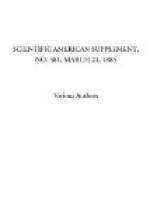[Illustration]
I will now show you by a practical utilization of the well known flameless combustion, how to light a coke furnace without either paper or wood, and without disturbing the fuel, by the use of a blowpipe which for the first minute is allowed to work in the ordinary way with a flame to ignite the coke. I then pinch the gas tube to extinguish the flame, allow the gas to pass as before, and so blow a mixture of unburnt air and gas into the fuel. The enormous heat generated by the combustion of the mixture in contact with the solid fuel will be appreciable to you all, and if this blast of mixed air and gas is continued, there is hardly any limit to the temperatures which can be obtained in a furnace. I shall be able to show you the difference in temperature obtained in a furnace by an ordinary air blast, by a blowpipe flame directed into the furnace, and by the same mixture of gas and air which I use in the blowpipe being blown in and burnt in contact with the ignited coke. In each case the air blast, both in quantity and pressure, is absolutely the same; but the roar and the intense, blinding glare produced by blowing the unburnt mixture into the furnace is unmistakable. The heat obtained in the coke furnace I am using, in less than ten minutes, is greater than any known crucible would stand. I am informed that this system of air and gas or air and petroleum vapor blast, first discovered and published by myself in a work on metallurgy issued in 1881, is now becoming largely used for commercial purposes on the Continent, not only on account of the enormous increase in the heat, and the consequent work got out of any specified furnace, but also because the coke or solid fuel used stands much longer, and the dropping, which is so great a nuisance in crucible furnaces, is almost entirely prevented; in fact, once the furnace is started, no solid fuel is necessary, and the coke as it burns away can be replaced with lumps of broken ganister or any infusible material. Few, if any, samples of firebrick will stand the heat of this blast, if the system is fully utilized. You will find it a matter of little difficulty, with this system of using gas, to melt a crucible of cast iron in an ordinary bed-room fire grate if the front bars are covered with sheet iron, with a hole (say) three inches in diameter, to admit the combined gas and air blast. The only care needed is to see that you do not melt down the firebars during the process. I will also show you how, on an ordinary table, with a small pan of broken coke and the same blowpipe, used in the way already described, you can get a good welding heat in a few minutes, starting all cold. In this case the blowpipe is simply fixed with the nozzle six inches above the coke, and the flame directed downward. As soon as the coke shows red, the gas pipe is pinched so as to blow the flame out, and the mixture of gas and air is blown from above into the coke as before. With this and a little practice, you can get a weld on a 7/8 inch round bar in 10 minutes.




